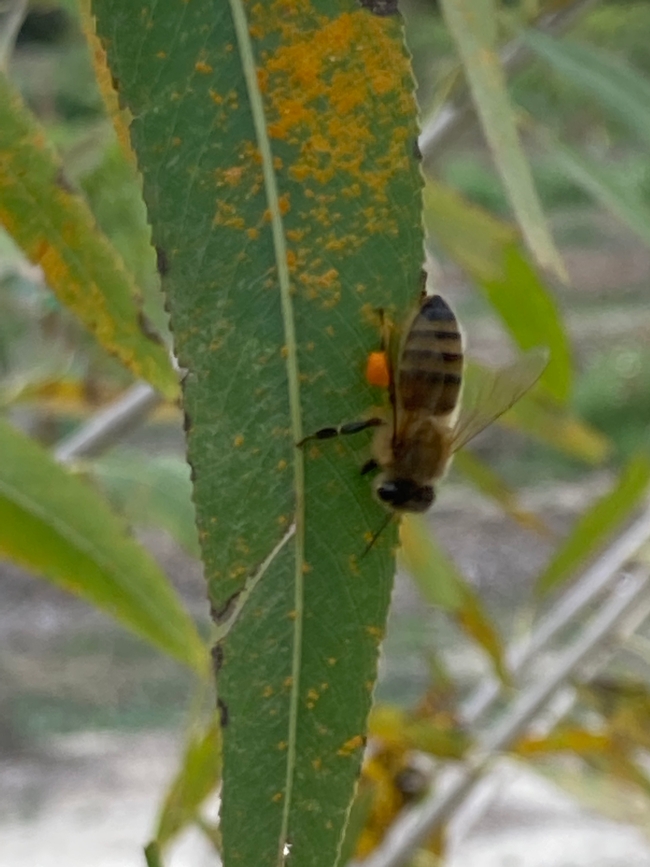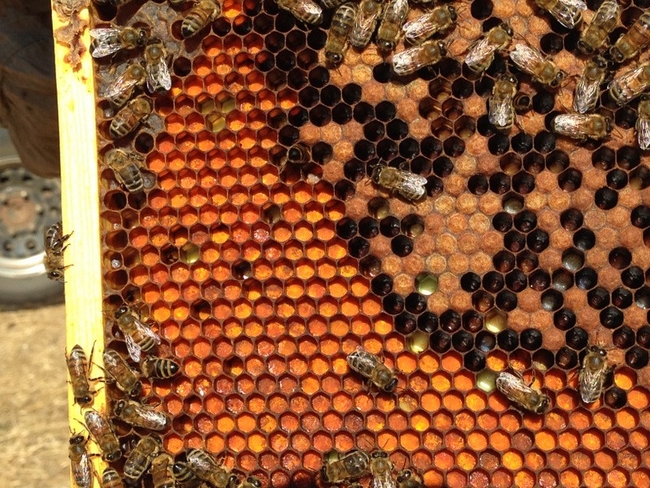Image: Allen King
A Fillmore grower recently reported honeybees collecting rust spores on willow trees!!! Her baskets are loaded with rust spores. Rust-collecting honeybees are reported by others so it's not an unusual occurrence.
From: Randy Oliver, “Fried Eggs” Identified! https://scientificbeekeeping.com/fried-eggs-identified/ Oliver shows bee-collected rust pollen from poplar trees in Spain in hive frames.
Quote: "Above is a photo of a typical comb filled with beebread consisting of rust fungus spores. Note the lousy brood pattern and the dying brood. When the colony is feeding upon this beebread, it goes downhill quickly. However, if we feed the hive several pounds of high-quality pollen sub, it will turn around immediately and grow again.
Antonio Pajuelo (pers comm) also reports a correlation between the consumption of poplar rust spores and colony mortality, but doesn't know whether it is due to spore toxicity or lack of better nutrition. It may be that the collection of rust spores is due to the lack of more attractive and nutritious floral pollen, and as such would simply be a generic indicator of poor colony nutritional status.
On the other hand, Schmidt (1987) found that caged bees fed Uromyces spores as a sole protein source actually had their lifespan reduced compared to those fed sugar syrup only—strongly suggesting that the spores were toxic. The spore-fed bees lived about 20 days less than those fed the most nutritious pollens!"
John Menge, a retired UC Riverside plant pathologist and mycologist has this reasoning:
The bee rust problem is very interesting.
I would have liked to work on that problem when I was at Riverside.
Two thoughts:
First I thought poplar rust was a Melampsora not Uromyces.
All the old literature gave the Uromyces name to all Uredospore stages.
Second, as you know, rusts have five different spore stages.
It would help to know what spore stages are in the hives.
One spore stage is pycniospores.
It is the spermatia stage and is sweet as honey.
It attracts all types of insects including bees.
Its job is to promote fertilization of the fungus so the bees are pollinating the fungus.
In the process of gathering the spermatia sugar, the bees are inadvertently gathering urediniospores.
Or perhaps there is lingering pycnia sugar on the urediniospores.
Or perhaps there are other attractants on the spore so the bees will disperse them.
At any rate I can tell the researchers are entomologists because they are worried about the bee colonies.
Mycologists worry about the cottonwood trees and the success of the rust fungi.
Apparently the fungi have outsmarted the insects again.

